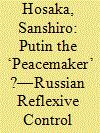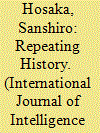| Srl | Item |
| 1 |
ID:
165342


|
|
|
|
|
| Summary/Abstract |
This article attempts to measure the multilayered, diverse historical memories of contemporary Ukrainians, drawing on a cluster analysis of nationwide survey data collected after the Euromaidan. A significant minority of Ukrainian citizens still gravitate toward Soviet–Russian narratives. These are not merely copies of those embraced in Russia, however; they include ambivalent ‘hybrid’ feelings of nostalgia for the Soviet Union while supporting Ukraine's independence. This article argues that historical memories of Ukrainians in the southern and eastern regions are amorphous and heterogeneous, and that the architects of the Novorossiya project failed to distinguish Soviet nostalgia from Ukrainophobia and separatist grievances.
|
|
|
|
|
|
|
|
|
|
|
|
|
|
|
|
| 2 |
ID:
169465


|
|
|
|
|
| Summary/Abstract |
This article examines Russia’s use of Reflexive Control, a Soviet-origin technique to control an adversary’s decision-making processes, during the invasion of Ukraine by scrutinizing daily monitoring reports received by Putin’s aide on the policy toward Ukraine, Vladislav Surkov, a possible political-military command. The Kremlin’s moves in political negotiations are closely intertwined with and supported by its military actions. Synchronization between Reflexive Control and combat control becomes more critical and complicated during the combat stage, as the initiator of Reflexive Control simultaneously seeks to maximize its political gains at the ‘peace’ negotiation table, the outcome of which depends not only on the success on the battlefields, but also on the situational awareness of the enemy (in democratic countries, both the leadership and the public) and international third parties.
|
|
|
|
|
|
|
|
|
|
|
|
|
|
|
|
| 3 |
ID:
186399


|
|
|
|
|
| Summary/Abstract |
Drawing on the formerly classified in-house journal KGB Collection, this article argues that active measures, commonly known as Soviet foreign influence operations, were the concept and practice in which offensive counterintelligence encroached on foreign intelligence functions. In the 1960s, KGB counterintelligence officers were urged to implement active measures, instead of passive surveillance, by cultivating and recruiting foreign visitors and Soviet citizens with the aim of using them to penetrate Western institutions and collect sensitive intelligence. The counterintelligence directorate occasionally supervised foreign operations to implement offensive tactics. Given the parallels between the Soviet and Russian intelligence services, the expansion of the counterintelligence agency (the Federal Security Service) in post-Soviet Russia can be interpreted as its increased interest in and capabilities for active measures abroad.
|
|
|
|
|
|
|
|
|
|
|
|
|
|
|
|